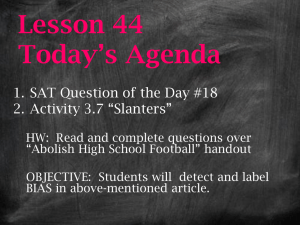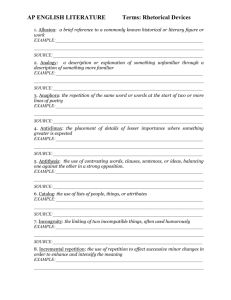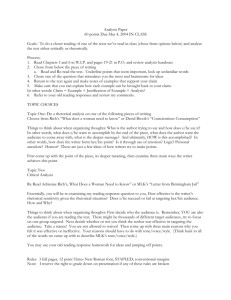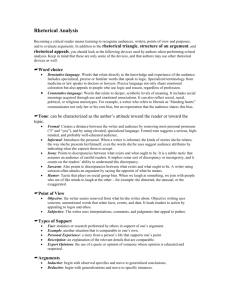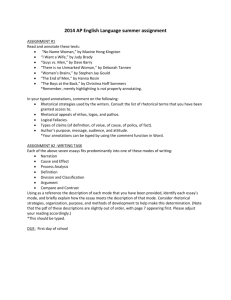Slanters
advertisement
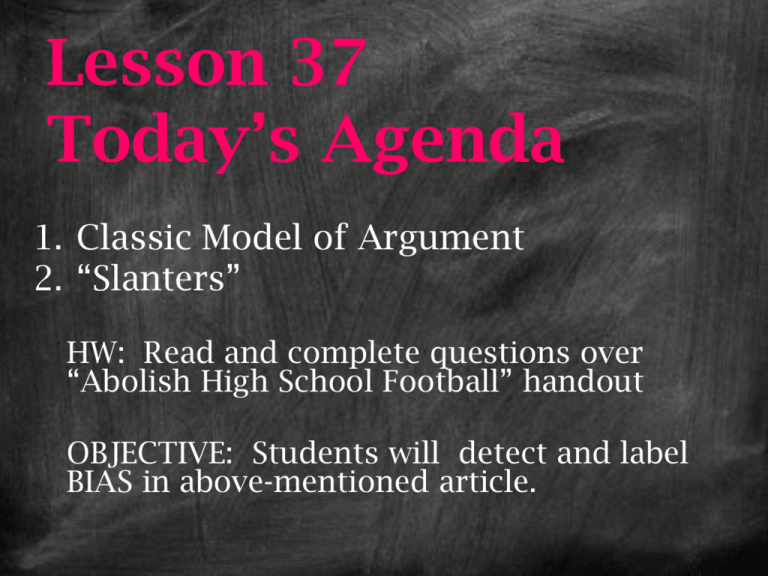
Lesson 37 Today’s Agenda 1. Classic Model of Argument 2. “Slanters” HW: Read and complete questions over “Abolish High School Football” handout OBJECTIVE: Students will detect and label BIAS in above-mentioned article. Classic Model of Argument – Claim •Where does it go? •What is the exception? – Evidence •What kind? – Concession •What does this do for argument? – Refutation •How does this support argument? – Conclusion • In timed writing situations… “Slanters” Writers often use inflammatory rhetorical techniques, known as slanters, in place of logical arguments. Slanters are used to manipulate readers into accepting a position. Today, we will look at a number of different types of slanters, which will ultimately be applied to make your more critical readers of argument. Slanters Sometimes a writer compensates for a lack of evidence and logical argumentation by using slanted language and emotional appeals to present a prejudiced depiction of a subject. A slanter is a rhetorical device used to present a subject in a biased way. Labeling – Euphemisms and Dysphemisms: Labeling is the use of a highly connotative word or phrase to name or describe a subject or action. It’s a technique also called using loaded language. When the connotations are positive (or less negative), the writer is using euphemism. Conversely, when overtly negative connotations are used, the writer is using dysphemism. For Example: Consider the differences between the terms preowned vehicle and used car. Pre-owned vehicle is a euphemism while used car is a dysphemism. Think of the terms freedom fighter and terrorist. Freedom fighter is a euphemism while terrorist is a dysphemism. Labeling – Euphemisms and Dysphemisms: Rhetorical Analogy A rhetorical analogy is the use of a figurative comparison (sometimes a simile or a metaphor) to convey a positive or negative feeling towards the subject. For Example: In the 2008 presidential race, Sarah Palin jokingly suggested that she was like a pit bull with lipstick. In another famous moment of the campaign, John McCain compared Barack Obama to Paris Hilton, thus suggesting he was an unqualified celebrity. Rhetorical Analogy Rhetorical Definition A rhetorical definition is the use of emotively charged language to express or elicit an attitude about something. A rhetorical definition stacks the deck either for or against the position it implies. For Example: When arguing against capital punishment, many people define it as “governmentsanctioned murder.” Rhetorical Definition Rhetorical Explanation A rhetorical explanation is expressing an opinion as if it were fact, and doing so in biased language. For Example: You might say someone “didn’t have the guts to fight back” when taunted by another person. This paints the person as motivated by cowardice. Or you might say the person “took the high road, instead of taking a swing.” Rhetorical Explanation Innuendo Innuendo is the use of language to imply that a particular inference is justified, as if saying “go ahead and read between the lines!” In this way, the speaker doesn’t have to actually make a claim that can’t be supported; instead, the audience is led to make the leap on their own. For Example: A presidential candidate might say, “Think carefully about whom you choose; you want a president who will be ready to do the job on day one.” The implication is that the opposing candidate is not ready. Innuendo Downplayers Downplayers is the use of qualifier words or phrases to make someone or something look less important or significant. Words like “mere” and “only” work this way, as well, as does the use of quotation marks, to suggest a term is ironic or misleading. Often these references are linked to concessions with connectors such as nevertheless, however, still, or but. For Example: “She got her ‘degree’ from correspondence school.”. Downplayers Hyperbole Hyperbole is the use of extravagant overstatement, which can work to move the audience to accept the basic claim even if they reject the extremes of the word choice. Many of the other slanters can be hyperbolic in the way they are worded, but the key part is that the statement or claim is extreme. For Example: In response to a dress code, a student might say “This school administration is fascist!” Hyperbole Truth Surrogates Truth Surrogates hint that proof exists to support a claim without actually citing that proof. If the evidence does exist, the writer is doing a poor job of citing it; meanwhile, the writer has not actually identified any source – or made any claim – that can be easily disproven or challenged. For Example: Ads often say “studies show,” and tabloids often say things like “according to an insider” or “there’s every reason to believe that . . .” Truth Surrogates Ridicule/Sarcasm Ridicule or Sarcasm is the use of language that suggests the subject is worthy of scorn. The language seeks to evoke a laugh or sarcastically mock the subject. For Example: This week, in the New York Daily News, Hank Gola says the following about Tony Romo “The G-forces between those poles have Romo taking the faithful on a dizzying ride that often leads to nausea. The maddening things is that he doesn't stink. He just does dumb things.” Gola is ridiculing Romo for losing a game in the fourth quarter, again. Ridicule/Sarcasm Identify it! Now that you have read and marked the text, go back to the beginning of the editorial, “Abolish High School Football!” and identify the following slanters as follows: Labeling – Highlight Rhetorical Definition – Underline Innuendo – Mark with an *asterisk* Hyperbole – Underline with a swiggly line Ridicule/Sarcasm – Circle Generalize it! Ok, so now you have read the editorial “Abolish High School Football!” and identified the slanters used, the last step is to use deductive reasoning to compose a generalization about the following “essential question”: How does a writer use tone to advance an opinion? Write your generalization as a complete sentence.
